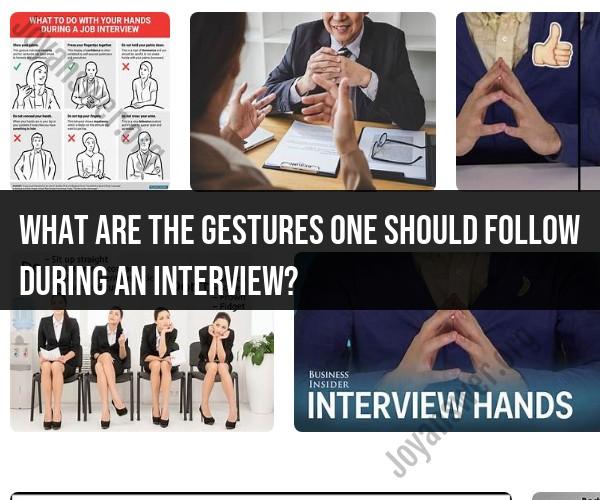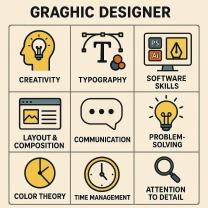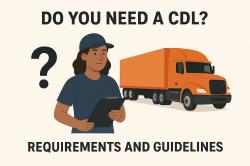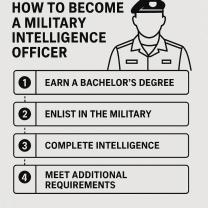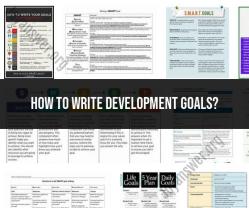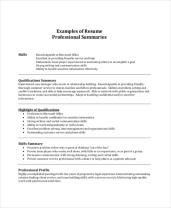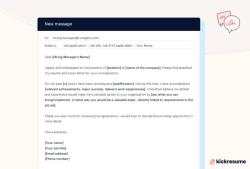What are the gestures one should follow during an interview?
During a job interview, your gestures and behavior play a crucial role in making a positive impression. Here are some essential gestures and behavior tips to follow during an interview:
Handshake:
- Offer a firm, confident handshake when you meet the interviewer(s).
- Maintain eye contact and smile as you shake hands.
- Avoid a limp or overly strong grip.
Eye Contact:
- Maintain good eye contact with the interviewer throughout the conversation.
- Eye contact conveys confidence and attentiveness.
- Avoid staring, which can be perceived as aggressive, or excessive blinking, which may indicate nervousness.
Smile:
- Smile genuinely to create a friendly and positive impression.
- Smiling shows enthusiasm and approachability.
Posture:
- Sit up straight with good posture in the chair.
- Avoid slouching or leaning back too far.
- Leaning slightly forward can convey engagement.
Gesture Moderation:
- Use gestures naturally to emphasize points or express enthusiasm.
- Avoid excessive or distracting gestures that may detract from your message.
Active Listening:
- Show that you are actively listening by nodding and providing verbal cues, such as "I see" or "I understand."
- Avoid interrupting the interviewer while they are speaking.
Mirroring:
- Subtly mirror the body language and tone of the interviewer to establish rapport.
- Don't mimic every movement, but align your posture and gestures to some extent.
Confident Speech:
- Speak clearly and at a moderate pace.
- Avoid speaking too fast or too slowly.
- Eliminate filler words like "um," "uh," or "like."
Engage with Your Hands:
- Use your hands to express yourself, but do so naturally.
- Avoid distracting or repetitive hand movements.
Dress Appropriately:
- Wear professional attire that is suitable for the industry and company culture.
- Dressing appropriately is a gesture of respect for the interviewer and the organization.
Respect Personal Space:
- Maintain an appropriate personal space distance during the interview.
- Invading someone's personal space can make them uncomfortable.
Stay Calm:
- Keep nervous habits in check, such as fidgeting, tapping your fingers, or bouncing your leg.
- Take deep breaths to calm nerves if necessary.
Cell Phone Etiquette:
- Turn off or silence your cell phone before the interview.
- Avoid checking your phone or allowing it to interrupt the conversation.
Thank You:
- End the interview by expressing your gratitude for the opportunity to interview.
- Offer a polite thank you and a firm handshake when appropriate.
Follow-Up:
- After the interview, send a thank-you email or note to reiterate your interest in the position and express appreciation for the interview opportunity.
Remember that non-verbal communication, including gestures and body language, can be as important as what you say during an interview. Being mindful of these gestures and behavior tips can help you make a positive impression and increase your chances of success in the interview process.
Gestures in Interviews: What to Do and Avoid
Gestures are a natural part of communication, and they can be used to convey a variety of messages, such as enthusiasm, confidence, and engagement. However, it is important to be mindful of your gestures in an interview, as they can also send the wrong signals to the interviewer.
Here are some tips for using gestures effectively in an interview:
- Use open and welcoming gestures. Avoid crossing your arms or legs, as this can make you appear closed off or defensive. Instead, use open gestures, such as extending your hands in a handshake or sitting with your arms at your sides.
- Use gestures to emphasize your points. Gestures can be used to emphasize key points in your answers and to show the interviewer that you are engaged in the conversation. For example, you might nod your head to show agreement or use a hand gesture to illustrate a point.
- Be mindful of your body language. Your body language should convey confidence and professionalism. Avoid fidgeting or slouching, as this can make you appear nervous or uninterested. Instead, sit up straight and make eye contact with the interviewer.
Here are some gestures to avoid in an interview:
- Avoid fidgeting. Fidgeting, such as tapping your foot or playing with your hair, can make you appear nervous or distracted.
- Avoid slouching. Slouching can make you appear uninterested or unprofessional.
- Avoid crossing your arms or legs. Crossing your arms or legs can make you appear closed off or defensive.
- Avoid pointing. Pointing can be considered rude or aggressive.
- Avoid avoiding eye contact. Avoiding eye contact can make you appear nervous or unconfident.
It is also important to be aware of cultural differences when using gestures in an interview. For example, in some cultures, it is considered rude to point at someone. It is always best to err on the side of caution and avoid using gestures that could be misinterpreted.
By following these tips, you can use gestures effectively to convey a positive message to the interviewer and increase your chances of landing the job.
